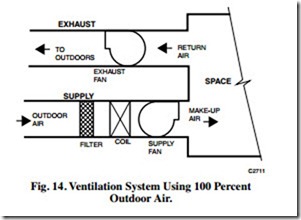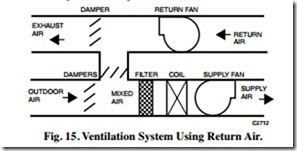VENTILATION
Ventilation introduces outdoor air to replenish the oxygen supply and rid building spaces of odors and toxic gases. Ventilation can also be used to pressurize a building to reduce infiltration. While ventilation is required in nearly all buildings, the design of a ventilation system must consider the cost of heating and cooling the ventilation air. Ventilation air must be kept at the minimum required level except when used for free cooling (refer to ASHRAE Standard 62, Ventilation for Acceptable Indoor Air Quality).
To ensure high-quality ventilation air and minimize the amount required, the outdoor air intakes must be located to avoid building exhausts, vehicle emissions, and other sources of pollutants. Indoor exhaust systems should collect odors or contaminants at their source. The amount of ventilation a building requires may be reduced with air washers, high efficiency filters, absorption chemicals (e.g., activated charcoal), or odor modification systems.
Ventilation requirements vary according to the number of occupants and the intended use of the space. For a breakdown of types of spaces, occupancy levels, and required ventilation, refer to ASHRAE Standard 62.
Figure 14 shows a ventilation system that supplies 100 percent outdoor air. This type of ventilation system is typically used where odors or contaminants originate in the conditioned space (e.g., a laboratory where exhaust hoods and fans remove fumes). Such applications require make-up air that is conditioned to provide an acceptable environment.
In many applications, energy costs make 100 percent outdoor air constant volume systems uneconomical. For that reason, other means of controlling internal contaminants are available, such as variable volume fume hood controls, space pressurization controls, and air cleaning systems.
A ventilation system that uses return air (Fig. 15) is more common than the 100 percent outdoor air system. The return- air ventilation system recirculates most of the return air from the system and adds outdoor air for ventilation. The return-air system may have a separate fan to overcome duct pressure losses. The exhaust-air system may be incorporated into the air conditioning unit, or it may be a separate remote exhaust. Supply air is heated or cooled, humidified or dehumidified, and discharged into the space.
Ventilation systems as shown in Figures 14 and 15 should provide an acceptable indoor air quality, utilize outdoor air for cooling (or to supplement cooling) when possible, and maintain proper building pressurization.
For more information on ventilation, refer to the following sections of this manual:
— Indoor Air Quality Fundamentals.
— Air Handling System Control Applications.
— Building Airflow System Control Applications.

